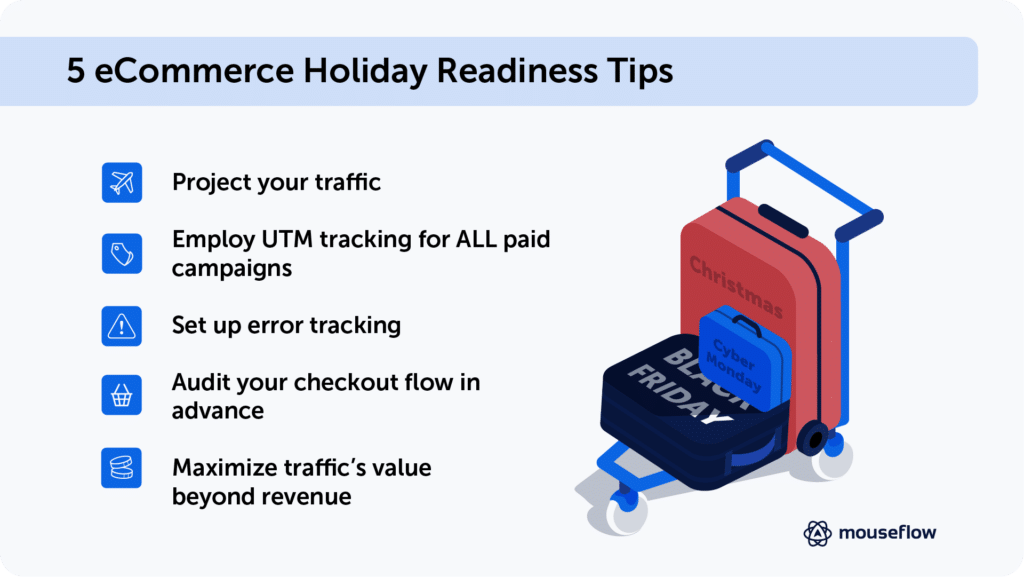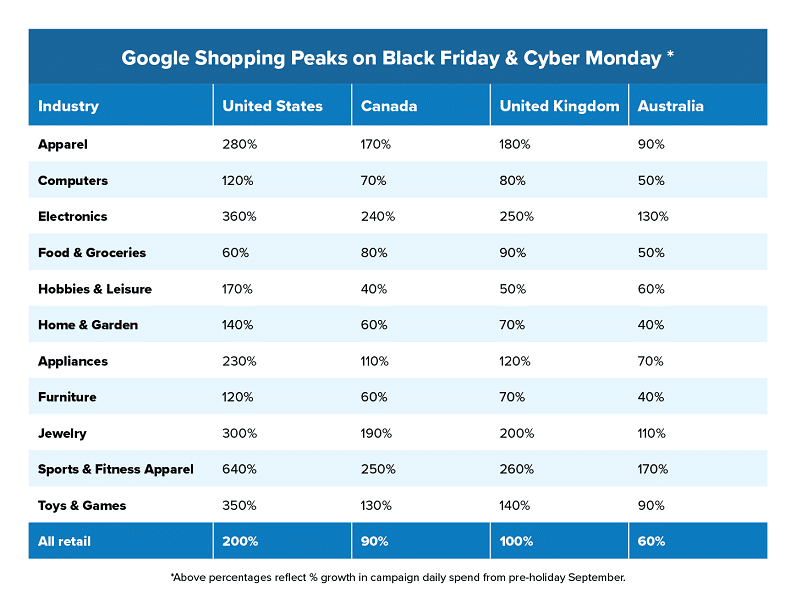- The Holiday Shopping Trifecta: Black Friday, Cyber Monday, and Christmas
- 5 Tips To Prepare Your eCommerce for the Holiday Season
- 1. Project Your Traffic for the Holiday Season
- 2. UTM Tracking Set Up for Paid Campaigns
- 3. Set Up Error Tracking
- 4. Audit Your Checkout Flow with Friction Score and Events
- 5. Maximize Your Traffic's Value Beyond Revenue
🎙 On the go? Listen to the article through our podcast, Cave Bits!
Listen to more episodes of Cave Bits
The final quarter of the year is a whirlwind of excitement and chaos for eCommerce businesses. With Black Friday, Cyber Monday, and Christmas just around the corner, it’s essential to have a solid strategy in place to make the most of this busy season.
And for this strategy to work, you should be preparing it much earlier than in the final quarter.
In this guide, we’ll provide expert advice on getting your eCommerce website ready for the holiday rush.
The Holiday Shopping Trifecta: Black Friday, Cyber Monday, and Christmas
Before diving into the nitty-gritty of holiday preparation for eCommerce, let’s take a moment to understand the significance of these three major shopping events:
1) Black Friday
Traditionally occurring the day after Thanksgiving, on the 4th Friday of November, Black Friday has evolved into a global shopping extravaganza. It’s a day when consumers are on the lookout for incredible deals and discounts.
But where does it all come from?
The myth of Black Friday is the retail world’s greatest bedtime story.
You see, there’s this widespread belief that for most of the year, retail stores were drowning in financial despair, their balance sheets painted a vivid shade of crimson. But lo and behold, when the holiday shopping season burst onto the scene, right after Thanksgiving, these beleaguered retailers were said to magically turn their fortunes around, transforming their balance sheets from red to black. Ta-da!
But hold your applause, because the real history of Black Friday is as different from this adopted myth as a sleek sports car is from a rusty old bicycle.
According to the savvy folks at Business Insider, Black Friday made its debut in the 1950s, thanks to the fine officers of the Philadelphia police department. It was a time when folks would flock to Philadelphia for two things: to gobble up Thanksgiving turkey and to witness the epic showdown known as the Army-Navy football game. As you can imagine, chaos reigned supreme on the day following Thanksgiving, leading to the birth of the term “Black Friday.”
Now, local Philly businesses weren’t exactly thrilled with this gloomy moniker, so they tried to rebrand it as “Big Friday.” But guess what? The original name, Black Friday, stuck around like an uninvited guest at a party.
Fast forward to 2003, and Black Friday had become such a sensation that it seized the title of the busiest shopping day of the year in the United States. And it hasn’t let go of that crown since. But wait, there’s more – this famous shopping extravaganza has crossed borders and taken the world by storm.
While Thanksgiving may be a North American holiday, the UK and Australia decided they couldn’t resist the Black Friday craze either. In the UK, they borrowed the term from the good ol’ police, but their Black Friday was all about the Friday before Christmas (at least in Cardiff). Apparently, it was a time when people partied hard and hospitals had a little more action than usual.
And down under in Australia and New Zealand, they’ve been tuning into the online shopping opportunities emanating from the U.S. since 2015. Major Kiwi retailers like The Warehouse decided it was high time to join the Black Friday party, offering their own sweet deals.
So there you have it – the myth busted and the quirky history of Black Friday unveiled. It’s a retail phenomenon that’s taken the world by storm, transforming “Black” into the most colorful shopping day of the year.
2) Cyber Monday
Following closely behind Black Friday, Cyber Monday is all about online shopping. Shoppers flock to websites for exclusive digital deals, making it a pivotal day for eCommerce businesses.
However, when did this construct happen?
Cyber Monday was born from the ever-evolving dance of consumer behavior, as eloquently elucidated by Barbara Kahn, the marketing maestro from The Wharton School of the University of Pennsylvania.
Picture this: it’s Monday, post-holiday weekend, and folks are back at their desks, finally reunited with their trusty companions – computers and the internet. Rewind to the ’90s and early 2000s when not everyone had a computer at home like we do today. Back then, being back at work meant one thing – the golden opportunity to peruse online-only retailers for jaw-dropping deals.
It was a gateway to a treasure trove of products not typically found in brick-and-mortar stores. Even retailers with both physical and online storefronts couldn’t resist the allure of Cyber Monday, seizing the chance to cast their net wider and snag a larger audience beyond the Black Friday in-person shoppers.
But what truly set Cyber Monday apart was its seductive blend of convenience and flexibility. No more frantic race to the store. Instead, you could snatch up deals whenever a free moment presented itself. Cyber Monday became the superhero of shopping – quick, accessible, and virtually omnipresent. The convenience was exhilarating, and the freedom to shop from practically anywhere added a dash of novelty to the sales extravaganza.
Now, in a world where the internet follows us like a loyal sidekick on our phones, tablets, laptops, watches, and smart home devices, the original rationale behind Cyber Monday might seem a tad “archaic,” as Kahn so aptly put it. But make no mistake, its legacy endures. Cyber Monday birthed a whole new breed of holiday sale – one that unfolded exclusively in the virtual realm – and stretched the shopping weekend’s timeline to unprecedented lengths.
In essence, Cyber Monday may have shed its ’90s roots, but its spirit lives on as the digital darling of the shopping world, a testament to the ever-evolving landscape of consumer habits and the enduring allure of incredible online deals.
3) Christmas
The holiday season, culminating in Christmas, is when people are in a generous mood, looking for the perfect gifts for their loved ones. This period offers an extended opportunity for eCommerce stores to boost sales.
I thought about dropping some lines about the story behind Christmas, but I’ll spare you with the history of how this came to be.
Now that we’ve set the stage, let’s delve into the essential steps to ensure your eCommerce website is holiday-ready.
5 Tips To Prepare Your eCommerce for the Holiday Season
I’ll also spare you the obvious “make sure you have enough items in stock” advice and focus on things relevant to my area of expertise – and that’s website analytics.
So, I have 5 eCommerce holiday readiness tips for you:
 UTM tracking for ALL paid campaigns 3) Set up error tracking 4) Audit your checkout flow in advance 5) Maximize traffic’s value beyond revenue” width=”1024″ height=”577″ />
UTM tracking for ALL paid campaigns 3) Set up error tracking 4) Audit your checkout flow in advance 5) Maximize traffic’s value beyond revenue” width=”1024″ height=”577″ />
1. Project Your Traffic for the Holiday Season
You’d want to have some idea of how many people are going to visit your website during the upcoming shopping holidays for two main reasons:
- Your website needs to survive the influx of shoppers.
- You want realistic goals as a part of getting an eCommerce business ready for the holidays.
For that, you’ll need some traffic estimations. How can you estimate it?
a) Based on Previous Years:
Start by analyzing your website traffic data from previous holiday seasons. This historical data will provide insights into traffic patterns and help you anticipate surges.

Expert tip
Head to your website analytics tool of choice, and look back at how your traffic fluctuated if you ran any promos.
Bear in mind that if you ran ads last year, you need to also assess how budgeting might affect your traffic in the upcoming season.
b) Based on Industry Benchmarks:
Research industry-specific data on holiday season traffic growth. This can give you a broader perspective on what to expect and how you compare to competitors. For example, “In the US, retailers can expect 3x their usual daily traffic, spend, and sales on Black Friday and Cyber Monday as the holiday season reaches its peak. Big ticket items — Jewelry, Appliance, Electronics, and Computers — are iconic grabs for the holidays, and retailers in these industries can expect even more searches than usual on these big days.”
You can check out this wonderful article by Mark Irvine at Wordstream that covers Google Shopping Holiday Forecast for YOUR industry.

Google Shopping Peaks on Black Friday and Cyber Monday (Source: Wordstream)
c) Traffic Breakdown:
Understand the breakdown of your traffic between paid channels (such as advertising) and organic sources. This insight will help you allocate your resources effectively.
This is crucial to develop a sound holiday eCommerce strategy for this year. Analyzing where traffic and conversions come from may help you fine tune your channels so that you can transform those visits into customers.
d) Review Your Tracking Setup:
Ensure your tracking tools are up to date and functioning correctly. Are you capturing all your traffic accurately? Let’s talk about a cardinal rule that every savvy data analyst should engrave in their toolkit: Do not sample your data.
Data is the lifeblood of analytics. It’s the raw material we transform into knowledge, and the accuracy of that transformation hinges on having the complete, unaltered dataset at our disposal. Sampling, while it might seem like a convenient shortcut, can lead to missed opportunities and skewed conclusions.
Imagine you’re on a quest for hidden gems in a vast mine. You have two options: either examine every single rock meticulously or randomly pick a handful and hope they represent the entire treasure trove. Sampling is like choosing the latter option; it’s a gamble. You might get lucky and stumble upon something valuable, but more often than not, you’ll miss the real treasures hidden in the unexamined rocks.
When you sample your data, you risk overlooking critical patterns, outliers, or rare events. Think about it: that one extraordinary data point, the outlier, could hold the key to unlocking a breakthrough insight or uncovering a lurking issue. By tossing it aside with sampling, you’re essentially throwing away a diamond in the rough. That’s especially true when it comes to behavior analytics data, because in behavior analytics individual session recordings matter a lot.
8 Reasons Why You Shouldn’t Sample Your Data, Especially if You Are an eCommerce:
- Personalization precision: Personalization is the holy grail of eCommerce. Shoppers expect tailored recommendations and experiences. To achieve this level of customization, you need a complete dataset that reflects individual preferences, past purchases, and browsing history. Sampling sacrifices this level of detail, hindering your ability to serve customers what they truly desire. Read more on eCommerce personalization from Omnisend.
- Micro-moments matter: Understanding customer behavior at a granular level and acting on it equals eCommerce success. Shoppers make split-second decisions, and every click, hover, or hesitation can hold valuable insights. By not sampling your data, you capture the essence of these micro-moments, enabling you to optimize your website for a seamless and frictionless shopping experience. Read more about optimizing micro-interactions.
- Detecting fraud and anomalies: E-commerce is not just a playground for legitimate customers; it’s also a hotspot for fraudulent activity. From payment fraud to account takeovers, unusual patterns and anomalies are often the first signs of trouble. A complete dataset allows you to spot these irregularities more effectively and respond promptly to protect your business and customers.

Fight Chargebacks
You can use Mouseflow to fight chargebacks by using session replay as indisputable evidence for intent on every transaction.
- Inventory and demand forecasting: Effective inventory management is a make-or-break factor in eCommerce. Accurate demand forecasting relies on analyzing historical sales data in its entirety. Any sampling introduces the risk of missing seasonality patterns, trending products, or subtle shifts in consumer preferences that could impact your inventory decisions.
- Better conversion rate optimization: Conversion rate optimization (CRO) is the heart of eCommerce. You’re constantly tweaking product listings, checkout flows, and CTAs to maximize conversions. Sampling reduces the precision of your insights into what’s working and what’s not. Without the complete data, you might miss critical conversion opportunities.
- Customer lifetime value (CLV) insights: Knowing your customers inside out is essential for long-term success. Customer lifetime value calculations depend on a holistic understanding of customer interactions, from their initial visit to repeated purchases. Sampling could lead to inaccurate CLV assessments, affecting your marketing and retention strategies.
- Adaptive marketing: Every click comes with a price tag, making data-driven decisions is vital. Without complete data, your attribution models might be flawed, and you could end up misallocating your ad budget, missing out on high-converting keywords, or misunderstanding the impact of your marketing campaigns.
- Competitive edge: eCommerce is extremely competitive, and the ability to analyze all your data gives you a competitive edge. You can spot trends, consumer preferences, or operational inefficiencies faster and respond more effectively.
Need help with tracking your eCommerce? Mouseflow offers a comprehensive tracking guide specifically designed for eCommerce businesses.
2. UTM Tracking Set Up for Paid Campaigns
Understanding the source of your traffic is crucial for any website that’s trying to sell something. Utilize UTM parameters to track the effectiveness of your paid campaigns in tools like Google Analytics 4 (GA4) and Mouseflow. This will help you make data-driven decisions and optimize your marketing efforts.
With the introduction of GA4, many customers have found themselves with ‘unassigned’ traffic sources. This can absolutely kill any analysis and optimization as you won’t be able to decipher where your traffic is coming from.
Here is a video from Julius from Analytics Mania explaining how to prep your GA4 property and traffics to speak the same language:
Mouseflow, on the other hand, will automatically pick UTM parameters up and make them available instantly in the advanced filtering. Hack away that traffic and find the insights you need to grow your revenue!
3. Set Up Error Tracking
At least once in your life, you’ve faced a broken button. Frustrating, right? Imagine how it is for an eCommerce that relies on that button working to not figure out on time that purchases are not happening because of a broken button. Ouch!
Same thing happens with coupon errors. Most likely, you’ll be considering offering discounts and promotions during the holidays. But what if your coupon is in a language that’s confusing? Maybe the marketing team went on a trip to make it interesting (Guilty!), and while great on paper, in practice you are provoking a frustrating experience for that customer.
With Mouseflow, you can set up error tracking for forms and coupon submissions.
4. Audit Your Checkout Flow with Friction Score and Events
Consider looking for Click-Error and Click Rage events to audit your checkout process. Identify any friction points that might deter customers from completing their purchases and hurting your capacity to reach your goals.
The Impact of Click-Errors and Click Rage
Click-Errors, or JavaScript errors, occur when your web store’s JavaScript code decides to have a temper tantrum.
Now, let’s talk about impact – because, oh boy, do these errors pack a punch in the e-commerce arena. They’re the grinches that steal your potential sales, the ghost shoppers that abandon their carts, and the invisible barriers between your customers and the checkout button.
Picture this: a potential buyer is perusing your beautifully designed product pages, ready to make a purchase, but then a JavaScript error pops up like an unwanted party crasher, leaving your customer frustrated and clicking the dreaded “exit” button instead of “buy now.”
These errors, often invisible to users, with their knack for breaking crucial functionalities, can send your bounce rates skyrocketing, make your conversion rates plummet, and turn your once-happy customers into disgruntled critics on social media.
Click Rage is similar. It’s the exasperating moment when you click on something online — say, a button or a link — and it just refuses to do what you want it to do.
It’s like trying to open a door that’s stuck, only in the digital world. There can even be no errors, as the element – most likely, by accident – wasn’t even designed to be clickable. So, you won’t notice it looking into the console.
However, Click Rage is just as big a source of frustration, as Click Errors. Even if there’s a workaround, more often than not users just don’t have the patience to find out how to get things to work. Click Rage is usually one the last thing that happens before they leave.
How Do You Track Click Errors and Click Rage?
By installing a weightless script on your website, Mouseflow allows you to automatically track these and many other friction errors. All done without any extra configuration. Just “plug and play”.
Once you start tracking your traffic, Mouseflow will tag your shoppers’ sessions with 6+ Friction Events with the help of its Friction Score engine that you can use to segment your data and watch recordings of what caused these undesirable behaviors.

Expert tip
Use Mouseflow’s Friction Score filter for ‘very unhappy’ when analyzing your checkout funnel to quickly identify where your shoppers are dropping off and why.
5. Maximize Your Traffic’s Value Beyond Revenue
Don’t just focus on immediate revenue. Use the surge in traffic during the holiday season as an opportunity to experiment and gather valuable data. These high-traffic periods present a unique opportunity to gather invaluable insights about your customers’ behaviors, preferences, and pain points.
By conducting experiments during these peak shopping times, you can test new strategies, product placements, pricing models, and eCommerce website optimizations to see what resonates most with your audience. Not only does this allow you to maximize revenue during the holidays, but it also provides a wealth of data to inform your long-term eCommerce strategy.
Remember, every surge in traffic is a chance to learn, adapt, and ultimately enhance your online shopping experience for customers year-round.
Need inspiration for this upcoming season? Check out this curated checklist of more than 250 eCommerce hacks.
What’s in the checklist?
- Intuitive inventory of 250+ hacks to try split into objectives
- Real-life example for each hack so you know how other successful shops have done it
- Hacks to improve AOV and CLTV
- Experiment tracker and ICE calculator to facilitate prioritization


